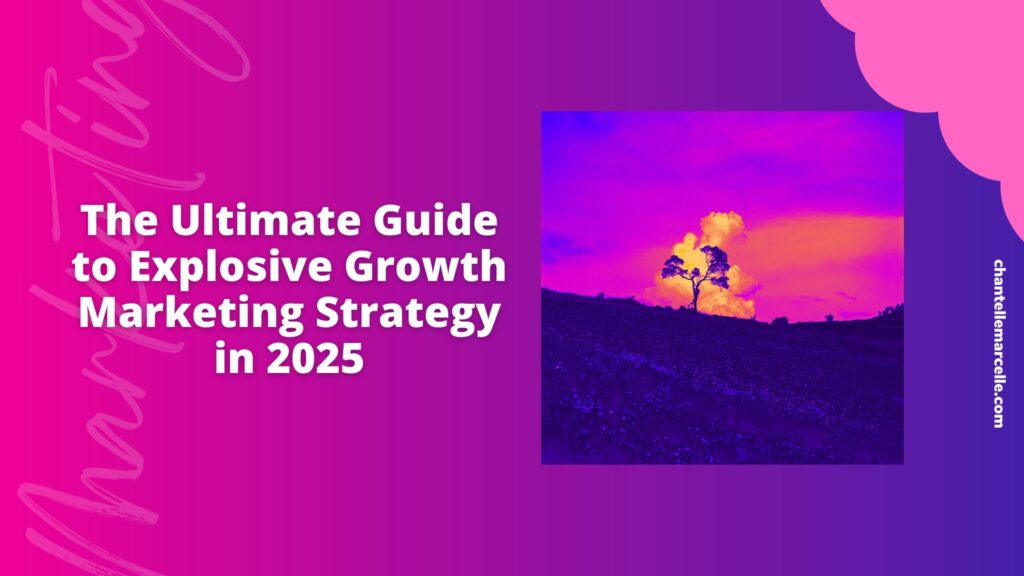

Growth Marketing: The Ultimate Guide to Explosive Business Growth in 2025
In This Article:
- Understanding Growth Marketing in 2025
- Assessing Your Current Growth Position
- Data-Driven Strategies for Explosive Growth
- Implementing Cross-Channel Growth Tactics
- Measuring and Optimizing Growth Performance
About 90% of startups fail to achieve sustainable growth, despite spending an average of $30,000 annually on marketing.
Traditional marketing approaches no longer cut it in today’s fast-paced digital landscape. Growth marketing has eme]ged as the game-changer, helping companies like Airbnb and Dropbox achieve exponential success through data-driven experimentation and rapid iteration.
Duolingo’s $6-Billion Growth Marketing Case Study
Every growth marketing strategy tells a different story. While Netflix doubled its subscriber base through sophisticated A/B testing, Spotify grew through viral referral loops. These growth marketing case studies prove one thing: systematic, measurable approaches yield the best results.
As we approach 2025, businesses need a fresh playbook. Whether you’re a startup founder or a growth marketing expert looking for inspiration, this comprehensive guide will walk you through forward-thinking strategies, cutting-edge tools, and practical frameworks to accelerate your business growth.
Ready to transform your growth trajectory? Let’s dive in.
Understanding Growth Marketing in 2025
Growth marketing has transformed from a trendy buzzword into a systematic approach for driving sustainable business results. In this section, we’ll explore what growth marketing truly means in 2025, how it stands apart from traditional methods, and the framework that powers its effectiveness.
Definition and Evolution of Growth Marketing
Growth marketing is a comprehensive, strategic approach that guides potential customers through various stages from initial awareness to final conversion and beyond. Unlike traditional marketing campaigns, growth marketing focuses on relentless experimentation with an intense focus on customers’ changing preferences.
The concept originated from “growth hacking,” which emerged when startups needed innovative ways to rapidly expand their user base with limited resources. Over the last two decades, growth marketing has evolved from one-off growth hacking tactics spliced into a marketing strategy as a second thought into a more sophisticated approach that’s deeply integrated across multiple business functions.
Today, growth marketing represents the ability to harness the full capabilities of a business to provide the best experience for customers and, as a result, drive growth. According to McKinsey, 83% of global CEOs look to marketing to be a major driver for most or all of a company’s growth agenda. Furthermore, successful implementation of modern growth marketing approaches can surface 5 – 15% of additional growth while slashing marketing costs by 10 – 30%.
How Growth Marketing Differs from Traditional Marketing
Traditional marketing typically focuses on short-term, campaign-oriented goals and concentrates primarily on the top of the funnel (aka ToFu, if you’re into marketing lingo). It centers on generating awareness and demand.
Additionally, traditional marketing reviews its approach on a regular, annual, or semi-annual basis, making changes gradually over time. In days past, that was in part due to a lack of available metrics and a principal concern with sales figures over anything.
In contrast, growth marketing takes a more agile approach, focusing on:
- Data-driven decisions: Growth marketing relies on data analytics to make informed decisions, track performance, and continuously optimize strategies
- Full-funnel focus: Unlike traditional marketing that works mainly on awareness and lead capture, growth marketing touches all parts of the funnel
- Experimentation culture: Growth marketing thrives on A/B testing, user feedback, martech support, and market research to iterate rapidly
- ROI mindset: Growth marketers operate with financial rigor, closely monitoring investments and creating accountability
Perhaps most significantly, growth marketing strategies can lead to more effective, responsible use of marketing budgets and more impactful campaigns. By implementing a growth marketing plan that focuses on the right metrics, businesses create more efficient strategies that lead to higher returns and stronger outcomes.
The Growth Marketing Funnel
The growth marketing funnel has evolved beyond the traditional linear purchase path.
While traditional funnels might include just awareness, consideration, and decision stages, the growth marketing funnel typically incorporates five key stages: acquisition, activation, retention, revenue, and referral.
This modern approach acknowledges that the digital path to purchase is often complex, difficult to attribute, and rarely a straight line. The growth marketing funnel accounts for the fact that consumers enter, exit, and move around the funnel, and their shopping isn’t limited to a single brand or geographic area.
At each stage of the funnel, growth marketers employ specific tactics.
Get regular growth marketing strategy tips: Sign up for the Work the Funnel newsletter.
In the awareness stage, the goal is to capture potential customers’ attention and build brand recognition. For the acquisition/consideration stage, marketers focus on converting prospects who are already aware of the product into leads. During activation, the objective is guiding users toward initiating the buyer’s journey. Retention becomes crucial as it drives sustainable results through profitability.
Finally, in the referral stage, there’s the opportunity to create exponential growth through creation of growth loops. Satisfied customers convert into brand evangelists and recommend the product or service to others. As someone who’s worked on growth and referral strategy for a variety of companies over the years, I’d say this is where the magic happens. You expand your resources beyond your own force and amplify your influence throughout communities.
Unlike traditional marketing funnels that operate in only one direction, these growth loops drive sustainable and compounding growth by reinvesting in existing users through expanded use, repeat purchases, and referrals.
Assessing Your Current Growth Position
Before implementing any growth marketing strategy, you need a clear picture of where your business stands. Successful companies don’t just guess. They systematically evaluate their current position to identify the most promising paths forward.
Conducting a Growth Audit
A growth audit provides a structured assessment of your marketing performance and overall business health. This comprehensive review reveals what’s working, what’s not, and where hidden opportunities exist.
Start by examining your fundamentals, including profit and loss statements, cost metrics, and year-over-year growth trends. Gather this data monthly, quarterly, and yearly to respond quickly to market shifts. Beyond financial metrics, evaluate your marketing channels’ effectiveness across social media, SEO, paid advertising, and content distribution.
A complete growth marketing audit examines:
- Channel performance and ROI across all marketing activities
- Brand positioning and market perception
- Customer acquisition processes and costs
- Retention rates and customer lifetime value
- Team structure and resource allocation
Once the audit is complete, it’s a perfect way to ensure your marketing roadmap is pointing you in the right direction.
Identifying Growth Opportunities and Bottlenecks
Once your audit is complete, the next step involves recognizing both growth catalysts and barriers. Opportunities often hide in plain sight, particularly in customer feedback, market trends, and cross-selling potential.
Survey existing customers who already trust your brand, as they frequently provide the most valuable insights for potential new offerings. Direct surveys and questionnaires provide awesome customer feedback, but you can also find what they’re saying via organic communities or message boards (social media, Discord, etc).
Analyzing market and sales trends reveals emerging customer needs that align with your overall value proposition.
At the same time, identify bottlenecks blocking your growth. Common growth bottlenecks include:
- Setting the wrong goals without long-term vision
- Scaling operations before optimizing processes]
- Overextending resources across too many initiatives
- Management structures unsuited for your current size
- Inadequate marketing investment
Once you recognize the blockers for your team, it becomes easier to develop the right plan allocate resources to tackle these.
Setting Realistic Growth Targets for 2025
With a clear understanding of your position, strengths and challenges, you can establish meaningful 2025 marketing goals and targets for your growth marketing strategy. Effective goal-setting begins with an honest assessment of where you stand now versus where you need to be.
Initially, conduct a thorough review of your 2024 performance against key metrics such as revenue growth, client retention, and profitability. A SWOT analysis (Strengths, Weaknesses, Opportunities, Threats) provides valuable context for positioning your business strategically in the coming year.
Creating Digital Advertising Content That Converts
Rather than creating numerous vague objectives, successful businesses focus on only a few high-impact goals that will meaningfully advance growth. These should be SMART (Specific, Measurable, Achievable, Relevant, and Time-bound) and directly aligned with your long-term vision.
Next, determine measurable KPIs for tracking progress. Select metrics that align with your specific goals, as each business requires unique performance indicators. For growth marketing specifically, key metrics typically include customer acquisition cost, customer lifetime value, conversion rates, and revenue growth rate.
Keep in mind: The best marketers understand the value of benefitting from cross-functional input at stages like this. For example, streamlining communication between product, sales and marketing helps create goals that keep in mind the full needs of the organization. You also have the added plus of getting buy-in and alignment early on, which means more support as you begin the journey toward achieving them.
By systematically assessing your current position, you establish the essential foundation for explosive 2025 marketing growth.
Data-Driven Strategies for Explosive Growth
Successful growth marketing relies heavily on your ability to turn raw data into actionable insights. Modern companies that excel at growth marketing use sophisticated data strategies to drive decisions rather than relying on intuition alone.
Leveraging AI and Predictive Analytics
Predictive analytics use historical data combined with statistical modeling and machine learning to forecast future outcomes. This powerful approach helps identify patterns that inform strategic decisions and reveal opportunities. Most effective predictive models fall into three categories:
- Classification models categorize data based on historical patterns, helping segment customers or detect fraud
- Clustering models group similar customers together based on common attributes, enabling targeted marketing strategies
- Time-series models analyze data at specific time frequencies to predict future trends and behaviors
Companies implementing these models can optimize operations, reduce risks, and identify growth opportunities as the big data analytics market expands toward $924.39 billion by 2032.
Personalization at Scale
Personalization at scale involves analyzing customer data to deliver relevant experiences tailored to individual needs and preferences. When executed properly, this approach creates significant business impact (10 – 30% revenue uplift and 10 – 20% more efficient marketing).
To implement personalization effectively:
- Start with existing data rather than waiting for perfect information
- Focus on understanding customer behaviors and identifying key triggers
- Build cross-functional teams to facilitate testing and learning
- Establish the right technology infrastructure for data integration and decision-making
Michaels Stores demonstrates this impact, increasing personalized email campaigns from 20% to 95%, lifting email click-through rates by 25% and SMS campaigns by 41%.
First-Party Data Collection and Utilization
In today’s privacy-focused world, first-party data (information collected directly from customer interactions, such as visits to your website or on-page form submissions) has become essential. Unlike third-party cookies, first-party data provides accurate insights for personalization while respecting privacy concerns.
Not to mention, we continue to hear about the impending “death of the cookie,” despite that event being pushed back for years.
Effective collection methods include:
- Website behavior tracking
- Surveys and feedback tools
- Email newsletters
- Transaction tracking
- Customer service interactions
Once collected, this data enables personalized marketing, audience segmentation, and improved customer journeys. Moreover, first-party data helps identify untapped opportunities and remove friction points in the customer experience.
The best part?
First-party data belongs to your company, unlike third-party data that depends on your company’s use of specific platforms.
A/B Testing and Experimentation
A/B testing compares two versions of digital assets to determine which performs better. This approach eliminates guesswork by providing concrete data on what works. Growth-focused companies like Spotify, Airbnb, and Netflix view experimentation as fundamental to their success.
The experimentation process follows five steps:
- Define the problem and requirements
- Acquire and organize relevant data
- Pre-process data to remove anomalies
- Develop predictive models
- Validate and deploy results
Through continuous testing, companies can identify the highest-performing variations of marketing assets, leading to increased conversions and improved user experience. As a result, A/B testing becomes a core component of any growth marketing strategy rather than a one-time activity.
Implementing Cross-Channel Growth Marketing Tactics
Effective growth marketing requires seamless integration across multiple channels where your audience already exists. In 2025, standalone channel strategies no longer deliver optimal results. Now business growth depends on coordinated cross-channel growth marketing strategy.
Content Marketing that Converts
The data speaks for itself: more than 80% of people have purchased a product or service after consuming business content.
Creating content that converts starts with understanding audience intent at different funnel stages. High-converting content addresses specific pain points through tutorials, case studies, and user testimonials.
In fact, user-generated content has become crucial to content marketing as most people check reviews and value authentic input before making purchases. The most effective content strategies follow a tree structure with broad topics in main navigation with niche-specific content branching downward.
Social Media Growth Marketing Strategies
Social platforms are rapidly evolving from mere engagement tools into powerful conversion engines.
For 2025, proactive engagement strategies are gaining momentum, with 41% of organizations already testing this approach. The smartest brands now strategically comment on creator content to build community while expanding reach.
Notably, social listening has become one of the leading priorities for organizations, with 62% of marketers now using these tools to gather actionable insights.
Email Marketing Optimization
Email remains a high-ROI channel when properly optimized. Effective optimization includes mobile-responsive design, rich text formatting, and strategic CTAs that drive specific actions.
Personalization is essential. Emails containing a customer’s name in the subject line consistently achieve higher click-through rates. A/B testing different elements helps identify what resonates with your audience, from subject lines to email content and design elements.
SEO and Organic Growth
Despite algorithm changes, organic growth remains achievable through consistent, quality content. SEO drives over half of all website traffic, making it essential for sustainable growth.
The most effective approach involves evaluating top-performing competitor content and creating even better resources.
User intent should guide your content strategy. Focus on creating resources that educate and solve specific problems rather than keyword-stuffed content.
Paid Acquisition Channels
Strategic paid acquisition complements organic efforts by driving immediate traffic and boosting visibility.
Display ads have proven effective at every buyer’s journey stage, with one test showing a 50% increase in clicks when combining LinkedIn and display ads. And testing display ads alongside Google Ads led to a 7x increase in attributed pipeline.
For maximum impact, track metrics like cost per acquisition (CPA) and return on ad spend (ROAS) across all channels.
Measuring and Optimizing Growth Performance
The success of your growth marketing initiatives depends entirely on your ability to measure and optimize performance. Through methodical tracking and continuous improvement, you can transform raw data into actionable growth strategies.
Key Growth Metrics to Track
Effective growth marketing relies on monitoring the right metrics. Revenue metrics remain fundamental, as they directly reflect business stability and health. These include:
- Customer Acquisition Cost (CAC): Measures how much you spend to bring in a new customer
- Annual or Monthly Recurring Revenue (ARR or MRR): Calculates revenue change from year to year or month to month
- Customer Lifetime Value (LTV): Shows profit expected from a customer throughout their relationship with your brand
Beyond revenue, engagement metrics provide critical insights into user behavior. For instance, tracking feature usage rates helps identify which features deliver value and which might be eliminated. Meanwhile, retention rates highlight what customers think about your product, with low retention signaling potential revenue churn.
And lastly, customer satisfaction metrics like CSAT and NPS help detect potential detractors who might churn, allowing you to follow up and reduce overall churn rates.
Building a Growth Marketing Dashboard
A well-designed dashboard serves as a powerful launch point for data-driven conversations.
First, define its purpose clearly. You need to understand who will use it and what decisions they need to make based off the information. Then, include only essential metrics that support this intent and remove extra elements that don’t communicate the central data.
Organize information logically by grouping related metrics and establishing visual hierarchy through size and position. Importantly, provide context with your numbers to help viewers understand whether figures are good, bad, or unusual. For example, marketing losses or goal-misses in red quickly shows viewers where the gaps are.
Continuous Optimization Framework
Continuous optimization forms the pulse of sustainable growth marketing. The plan-launch-test-optimize process involves regular monitoring of marketing efforts throughout the campaign lifecycle.
First, establish a baseline with clearly defined KPIs. Then implement a testing cycle: monitor performance metrics, identify patterns, make adjustments, and measure results. This data-driven approach allows for more informed decision-making as businesses analyze patterns and continually optimize campaigns.
Through this framework, each optimization cycle leads to incremental improvements that compound into significant performance gains over time. Furthermore, continuous optimization extends beyond immediate results by fostering an organizational culture of adaptability and innovation].
Conclusion: Growth Marketing in 2025
Growth marketing stands as a vital force for business success in 2025, transforming how companies approach their expansion strategies. Rather than relying on traditional marketing methods, successful businesses now embrace data-driven experimentation, cross-channel integration, and continuous optimization.
Companies that thrive understand the need for systematic assessment of their current position, followed by strategic implementation of growth tactics across multiple channels. Additionally, these organizations recognize that sustainable growth comes from measuring the right metrics and making informed adjustments based on real-time data.
Most importantly, growth marketing success depends on your ability to adapt quickly, test consistently, and optimize based on results. Through careful attention to customer needs, strategic use of analytics, and commitment to continuous improvement, your business can achieve significant growth while maintaining efficiency in marketing spend.
Remember that growth marketing represents an ongoing journey rather than a destination. Start with clear goals, measure what matters, and adjust your strategy based on data-driven insights. Your path to explosive business growth awaits.
Interested in learning more about the best B2B newsletters? Sign up for my newsletter or subscribe to the Brand & Marketing YouTube channel to get fresh insight delivered to you weekly.


